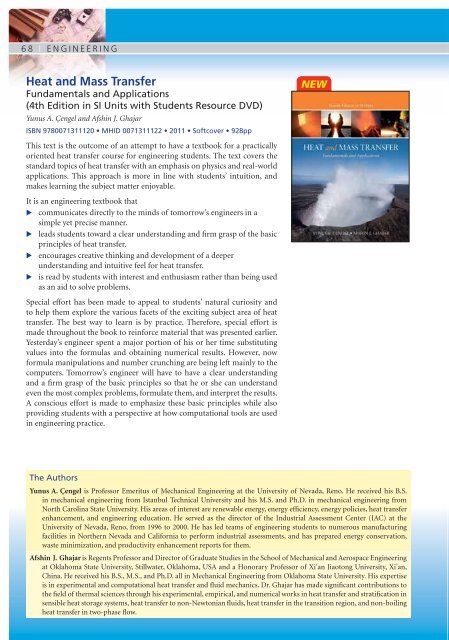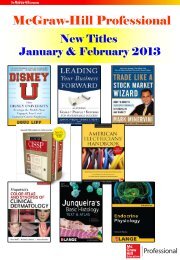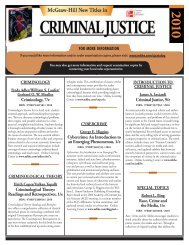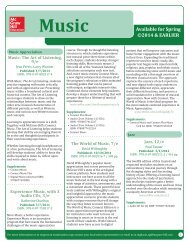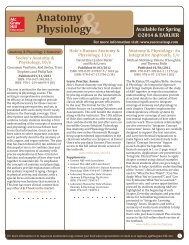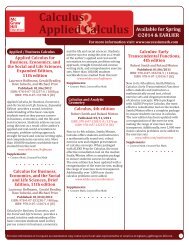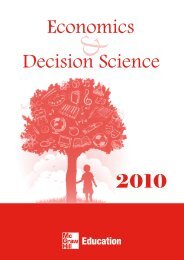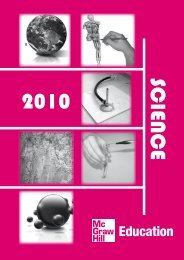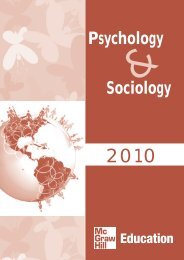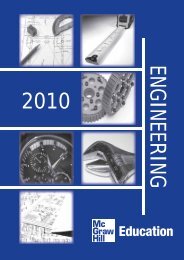Download - Mcgraw-hill.com.sg
Download - Mcgraw-hill.com.sg
Download - Mcgraw-hill.com.sg
- No tags were found...
You also want an ePaper? Increase the reach of your titles
YUMPU automatically turns print PDFs into web optimized ePapers that Google loves.
68 | ENGINEERING<br />
Heat and Mass Transfer<br />
Fundamentals and Applications<br />
(4th Edition in SI Units with Students Resource DVD)<br />
Yunus A. Çengel and Afshin J. Ghajar<br />
ISBN 9780071311120 • MHID 0071311122 • 2011 • Softcover • 928pp<br />
NEW<br />
This text is the out<strong>com</strong>e of an attempt to have a textbook for a practically<br />
oriented heat transfer course for engineering students. The text covers the<br />
standard topics of heat transfer with an emphasis on physics and real-world<br />
applications. This approach is more in line with students’ intuition, and<br />
makes learning the subject matter enjoyable.<br />
It is an engineering textbook that<br />
<strong>com</strong>municates directly to the minds of tomorrow’s engineers in a<br />
simple yet precise manner.<br />
leads students toward a clear understanding and firm grasp of the basic<br />
principles of heat transfer.<br />
encourages creative thinking and development of a deeper<br />
understanding and intuitive feel for heat transfer.<br />
is read by students with interest and enthusiasm rather than being used<br />
as an aid to solve problems.<br />
Special effort has been made to appeal to students’ natural curiosity and<br />
to help them explore the various facets of the exciting subject area of heat<br />
transfer. The best way to learn is by practice. Therefore, special effort is<br />
made throughout the book to reinforce material that was presented earlier.<br />
Yesterday’s engineer spent a major portion of his or her time substituting<br />
values into the formulas and obtaining numerical results. However, now<br />
formula manipulations and number crunching are being left mainly to the<br />
<strong>com</strong>puters. Tomorrow’s engineer will have to have a clear understanding<br />
and a firm grasp of the basic principles so that he or she can understand<br />
even the most <strong>com</strong>plex problems, formulate them, and interpret the results.<br />
A conscious effort is made to emphasize these basic principles while also<br />
providing students with a perspective at how <strong>com</strong>putational tools are used<br />
in engineering practice.<br />
The Authors<br />
Yunus A. Çengel is Professor Emeritus of Mechanical Engineering at the University of Nevada, Reno. He received his B.S.<br />
in mechanical engineering from Istanbul Technical University and his M.S. and Ph.D. in mechanical engineering from<br />
North Carolina State University. His areas of interest are renewable energy, energy efficiency, energy policies, heat transfer<br />
enhancement, and engineering education. He served as the director of the Industrial Assessment Center (IAC) at the<br />
University of Nevada, Reno, from 1996 to 2000. He has led teams of engineering students to numerous manufacturing<br />
facilities in Northern Nevada and California to perform industrial assessments, and has prepared energy conservation,<br />
waste minimization, and productivity enhancement reports for them.<br />
Afshin J. Ghajar is Regents Professor and Director of Graduate Studies in the School of Mechanical and Aerospace Engineering<br />
at Oklahoma State University, Stillwater, Oklahoma, USA and a Honorary Professor of Xi’an Jiaotong University, Xi’an,<br />
China. He received his B.S., M.S., and Ph.D. all in Mechanical Engineering from Oklahoma State University. His expertise<br />
is in experimental and <strong>com</strong>putational heat transfer and fluid mechanics. Dr. Ghajar has made significant contributions to<br />
the field of thermal sciences through his experimental, empirical, and numerical works in heat transfer and stratification in<br />
sensible heat storage systems, heat transfer to non-Newtonian fluids, heat transfer in the transition region, and non-boiling<br />
heat transfer in two-phase flow.


